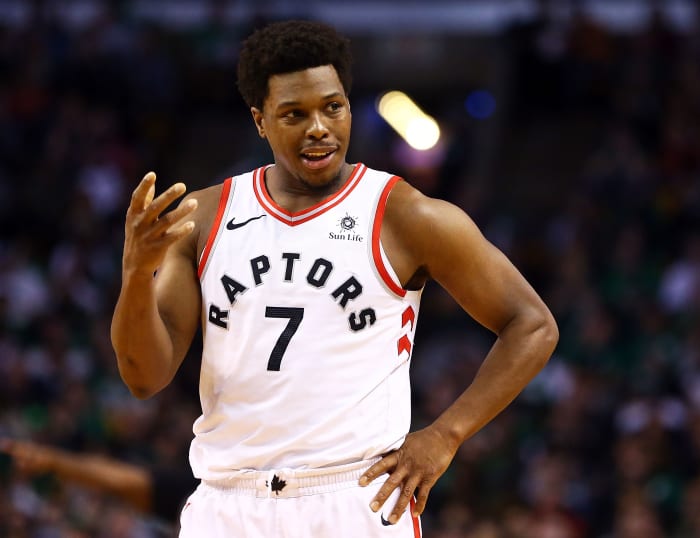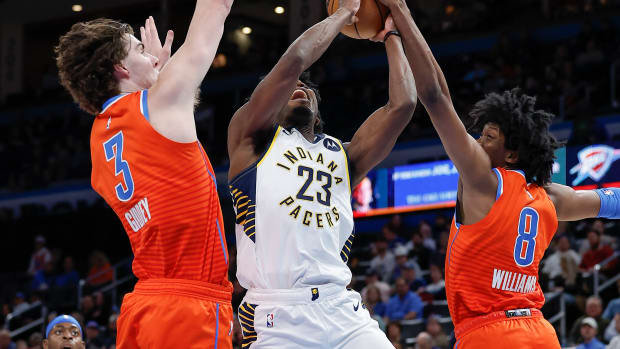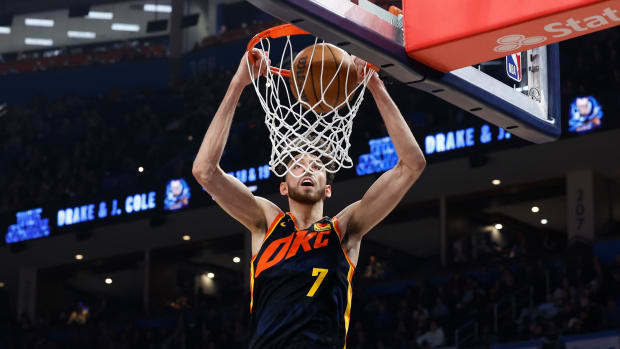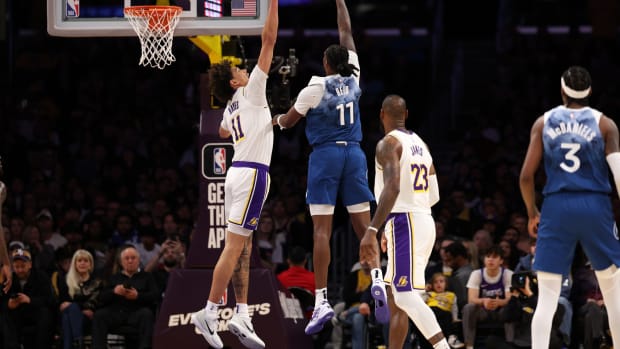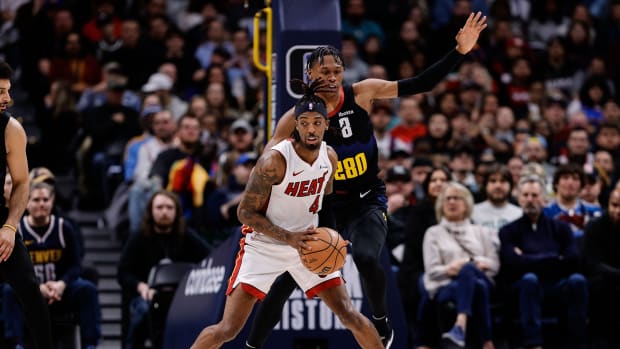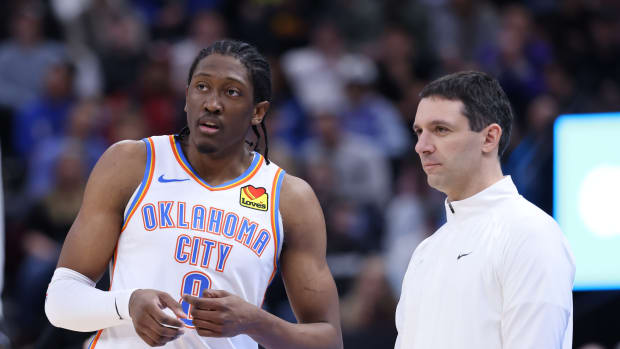The All-Bullseye Team: Five All-Stars Facing Serious Playoff Pressure
Pressure exists in all shapes, sizes and manners during the NBA playoffs. There’s the pressure to hit a game-winner, the pressure to earn a new contract, the pressure to play through pain, the pressure to adjust to mismatches, the pressure to stay calm, the pressure to re-write a reputation. And the list goes on.
The following is SI.com’s fifth annual All-Bullseye Team, which highlights five players who will be facing immense pressure and scrutiny during the upcoming 2018 playoffs. Note that previous All-Bullseye Team members—including James Harden, Chris Paul, Kevin Love and DeMar DeRozan—were not considered. Be sure to check out the 2014, 2015, 2016 and 2017 versions of this list.
(All stats through Tuesday.)
Kyle Lowry, Raptors
Toronto’s much-ballyhooed culture overhaul has produced a record-setting season and the East’s toughest challenger for LeBron James in years. Even better: The Raptors’ new approach has perfectly set up a referendum on Playoff Kyle Lowry.
Lowry, 32, spent the last three seasons performing like an All-NBA player and the last three postseasons looking more like an also-ran. Playoff Lowry has scored less, shot less efficiently, and earned fewer trips to the line than the regular-season version, with injuries and huge regular-season minutes often cited as contributing factors. Even as Toronto advanced to the 2016 East finals, he slogged more often than he sailed. Last year, Lowry exited with a whimper and an ankle injury, missing the final two losses of a sweep against Cleveland while openly admitting that “nobody’s closing the gap” on James.
The difference in Lowry’s performance once the postseason rolls around has been stark. His 39.4 postseason FG% ranks among the worst in NBA history for players with a similar number of attempts, his 31.4 postseason 3P% is way off his usual standard in Toronto, and his drop-off in overall shooting efficiency has been much greater than comparable players at his position.
To be precise, Lowry’s True Shooting % (TS%) drops from 56.4% in the regular season to 51.4% in the playoffs. Here’s how that steep decline compares to other All-Star guards with more than 50 games of postseason experience.
TS% change from regular season to postseason
• Kyle Lowry: minus-5%
• James Harden: minus-1.8%
• Russell Westbrook: minus-1.4%
• Stephen Curry: minus-1.2%
• Chris Paul: plus-0.4%
• Kyrie Irving: plus-0.5%
Breakaway: How DeMar DeRozan Keeps Defenses Guessing
Elite guards—whether they are super-efficient like Curry or not-that-efficient like Westbrook—usually shoot roughly similar percentages in the regular season and playoffs once they have built up a substantial body of work. Lowry bucks that trend, and he has suffered a greater drop-off than less-experienced postseason players like John Wall (minus-0.8) and Damian Lillard (minus-3).
Toronto hasn’t been able to survive Lowry’s Dr. Jekyll/Mr. Hyde act. When Lowry has pressed too hard or simply run cold, other weaknesses have been revealed, like DeMar DeRozan’s poor outside shooting and an offensive structure that was tilted too heavily towards its backcourt.
This is judgment year. Lowry has played just 32.5 MPG, down sharply from the last two seasons. He’s enjoyed near-perfect health, missing just three games all year. And his usage rate is down to 21.6, his lowest level since 2013, as Toronto has enjoyed substantial contributions from its league-leading bench. Optimists will note that Lowry should enter the 2018 playoffs fresher and healthier than at any point during his Raptors tenure. Critics will point out that the go-to excuses for his shaky postseason play—excessive burden, nagging injuries—no longer apply.
Ironically, Toronto has spent all season belying Lowry’s argument that “nobody has closed the gap” on James. The Raptors will set franchise records for wins and point differential. The re-made Cavaliers are arguably James’s worst team in a decade. There’s no question that the distance between the two teams has narrowed.
Despite DeRozan’s ascension and the emergence of Toronto’s deep bench, the formula for toppling James and winning the East starts with much better play from Lowry. Theoretically, the table is set: Cleveland has downgraded from Kyrie Irving to George Hill, Irving is presently injured in Boston, Washington’s John Wall has just returned from injury, and the conference’s other point guards possess weaker individual credentials or significantly less postseason experience. Toronto’s increased emphasis on ball movement has required sacrifices from Lowry, but it has also led to far more assisted baskets for him. If the Raptors stick with their improved habits, Lowry should continue to benefit. However, a reversion to pound-and-chuck from Lowry would amount to the ultimate frustration, and it would be reason to seriously explore trade possibilities this summer.
John Wall, Wizards
John Wall missed less than two months following knee surgery in January, but it felt like he was gone for two years. With their forgotten star sidelined, the Wizards went through an entire hype cycle in fast forward. “The season is over.” “Hey, maybe not, there’s still hope.” “Are the Wizards better without Wall?” “The Wizards are better without Wall!” “Nope, turns out the Wizards are not better without Wall.” “The Wizards really need Wall back.”
When the dust settled, Washington completed its Wall-less stretch with a respectable 12–7 mark. Importantly, the Wizards avoided the worst-case scenario—bottoming out to the ninth seed—and are in a three-way battle with the Heat and the Bucks for the East’s final three spots. While Bradley Beal made headlines for saying that Cleveland “didn’t want to see” Washington in the 2017 playoffs, Washington has every reason to manipulate its playoff positioning by stacking losses over the next week. By finishing seventh or eighth, the Wizards would avoid certain death at the hands of LeBron James in favor of a date with the Raptors or Celtics. That’s a very, very easy call.
Wall’s individual play hasn’t inspired much hope this season: His 19.2 PPG average is his lowest since 2013, his 41.5 FG% is his lowest since 2011, and his 19 Player Efficiency Rating is his lowest since 2012. Even so, the Wizards have a +4.1 net rating with him and a minus-1 net rating without him, and their preferred starting lineup of Wall, Beal, Otto Porter, Markieff Morris and Marcin Gortat has posted a +6.1 net rating. Coach Scott Brooks leaned heavily on that talented and balanced group during the 2017 playoffs, and they posted a killer +18 net rating against the Hawks and Celtics. Of course, Washington lost to Boston in large part because its bench-heavy units were hopeless. Even if he can’t perform like a superstar, Wall’s return is far, far better than the alternative, which likely would have involved playing Beal somewhere between 47.5 and 48 minutes per game.
NBA Power Rankings: The Red-Hot 76ers Are Surviving Life Without Joel Embiid
Washington is 2–2 against Toronto and 2–2 against Boston this season. Both opponents are potentially vulnerable, as the Raptors have had more than their fair share of playoff regression and the Celtics are waiting for Kyrie Irving to return from a knee injury.
But these playoffs are about far more than a first-round upset for Wall. He entered the season with a $200+ million supermax contract in hand, declaring himself the “best two-way point guard” in the NBA. After griping for years about the size of his contract relative to his peers, his injuries have created the uncomfortable possibility that Washington’s window may close before it ever opened. After all, the Wizards will live and die with the Wall/Beal/Porter trio, as all three have cashed in with major long-term contracts. One weak link among those three breaks the chain.
Wall was long viewed as the most reliable and spectacular of the three, but his growing injury history and ballooning contract now potentially make him the most burdensome. The Clippers didn’t hesitate to trade Blake Griffin and his long-term contract once it became clear his peak was lower than initially expected and his prime might not last as long as they hoped. Washington’s nightmare scenario involves weighing Wall’s future in a similar manner. Can any team justify paying a spotty-shooting point guard with balky knees more than $37 million every year from 2020 to 2023? Should any team talk itself into such a player if there are other young building blocks already in place?
That’s why the next four weeks are so huge for Wall. A resurgent postseason showing—even if it came in an early exit—would go a long way to quelling the pessimism and fear that inevitably bloomed during his absence.
Paul George, Thunder
It’s never a good sign when a star makes more headlines at the podium than on the court. That was Paul George’s 2017 postseason in a nutshell, as his venting throughout a first-round sweep loss to Cleveland foreshadowed his off-season departure from Indiana. Podium George’s most memorable complaint, of course, came after he didn’t have the ball on the final possession of Game 1. “I’ve got to get the last shot,” he grumbled.
Needless to say, George didn’t get an expanded late-game role when he was traded to the Thunder, where Russell Westbrook reigns supreme. This season, George has attempted just 55 shots in 169 clutch minutes over 41 games this season. As the chart below shows, his 20.3 usage rate in the clutch is lower than his last four healthy seasons in Indiana.
Westbrook, by contrast, has attempted 158 clutch shots—nearly three times as many as George. Oklahoma City’s Carmelo Anthony, despite being one of the league’s biggest disappointments, has 76 clutch attempts. And, in a twist, Indiana’s Victor Oladipo has enjoyed 101 clutch attempts this season—nearly twice as many as George—after the two players were traded for each other.
Put simply, George’s self-perception as a game-deciding closer has given way to a third-option reality. Perhaps this wouldn’t be an issue if the Thunder were performing well in close games or if George was locked into a long-term contract. Alas, Oklahoma City is a mediocre 23–22 in clutch games with Westbrook (41 FG%, 21 3P%) and Anthony (29 FG%, 21 3P%) both shooting very poorly late in games. That’s a recipe for frustration for all bystanders, including George, who has been slumping since the All-Star break and is set to be one of this summer’s top free agents.
The Emergence of Victor Oladipo Has the Pacers Going Above and Beyond
Remember, Westbrook’s gunning got worse in the 2017 postseason, not better. After posting a record 41.7 usage rate last season, he topped out at a 47 usage in the playoffs. The presence of George and Anthony should prevent a repeat of that laughably hopeless one-man approach. Still, George can expect postseason scrutiny in two distinct ways: 1) if Westbrook trusts him and he fails to deliver, and 2) if he is left watching with little say in the late-game action.
Will Westbrook and the Thunder find a way to strike a more appropriate late-game balance, one that produces wins in close games and manages to satisfy their All-Star small forward? If not, will George’s podium grumbles return before his career-shaping decision in July?
Draymond Green, Warriors
The natural response to Stephen Curry’s knee injury was to look for Kevin Durant to pick up the scoring slack. If one MVP goes down, the other simply delivers 34 points in a road win over the Thunder, right?
The story isn’t quite that simplistic. The Warriors don’t fully transfer responsibility, like one might shift a heavy bag from one shoulder to another. Instead, they diffuse the burden among their many capable parts. Golden State’s late-game performance against Oklahoma City on Tuesday night was a good example. Rookie guard Quinn Cook hit a key floater. Draymond Green connected with unheralded center Damian Jones for a lob. Klay Thompson nabbed a steal. Durant, Cook and Green all hit clutch free throws.
When playing full tilt, Green is both a menace and an expert diffuser. He sets up Golden State’s centers with high-low passes, he makes the right reads to open shooters, he initiates offense when necessary, and he helps provide spacing by moving around the perimeter freely. Defensively, he covers for his teammates in every imaginable way, whether calling out coverages, switching onto guards or stonewalling attempts around the basket.
How Vulnerable Are the Warriors Without Stephen Curry?
Golden State’s offensive rating falls by nearly 14 points when Curry leaves the court. No one player—not even an unleashed Durant—can compensate for that level of impact. however, Green’s versatility and intelligence make him ideally suited to helping five-man groups collectively pick up the slack. When Curry missed time with a knee sprain during the 2016 playoffs, for example, Green relished the opportunity to temporarily rework the Warriors in his own jawing, relentless image.
Coach Steve Kerr opened the season fretting about his team’s ability to stay motivated on a night-to-night basis, and those concerns proved justified. The Warriors have settled into cruise control for most of the season, ceding the No. 1 seed to the Rockets without much of a fight. Green, long viewed as Golden State’s engine, has been very good but somewhat less maniacal. He’s missed nearly as many games this season (8) as he did in the previous four seasons combined (10), and his 102.8 defensive rating is the worst mark of his career.
Draymond Green’s Defensive Rating
• 2018: 102.8
• 2017: 99.3
• 2016: 97.5
• 2015: 96
• 2014: 98.4
• 2013: 100.1
Simultaneously, Green has been as edgy as ever, accruing 15 technical fouls (second in the NBA) and three ejections (tied for second). To be clear, Green and the Warriors have earned every benefit of the doubt, and Durant brushed off questions about his own issues with the referees (14 technicals, five ejections) this week. Nevertheless, Curry’s absence drops the Warriors from “world-beaters” to “very good,” and it removes any margin for error when it comes to nonsense with the officials.
For Green, the immediate task is clear: He’s in charge of flipping the switch. If Golden State struggles in its first-round match-up, Green’s play—and any signs of slippage in impact or energy—will be the first thing to go under the microscope.
Jusuf Nurkic, Blazers
Portland’s Jusuf Nurkic enters the playoffs amid a perfect storm of narratives. The restricted-free-agent-to-be seeks redemption—for an ill-timed injury that kept him from contributing significantly during a 2017 first-round exit—and the first major payday of his career. As a traditional 7-foot center who plies his trade in the West, he must also be prepared for both the small-ball style that tends to dominate the playoffs and a host of talented centers.
To get to the Western Conference finals, the Blazers will likely have to contend with the Warriors, who downshift to smaller lineups with Draymond Green and Kevin Durant at will. At the same time, the Blazers’ most likely first-round opponents all have formidable centers: Oklahoma City’s Steven Adams, Utah’s Rudy Gobert, Minnesota’s Karl-Anthony Towns and New Orleans’s Anthony Davis.
Problems could arise for Nurkic, who has vacillated between punishing play and frustrating passivity, on both stylistic fronts. Against the likes of Adams and Gobert, he must avoid playing smaller than his size around the basket—a common lament among Blazermaniacs. Against Towns, Davis and the Warriors’ bigs, he must be prepared to defend in space out to the arc. When opponents stay big, he must play physically while avoiding foul trouble, as Portland’s other frontcourt options are largely finesse-oriented. When opponents go small, he must be mentally prepared to ride the pine for match-up purposes, something that’s been a major point of contention in the past.
The Blazers Have a Ceiling, But Damian Lillard Will Try to Break Through It Anyway
At first glance, it’s tempting to be a bit gloomy about Nurkic’s playoff fate, as he lacks three-point range and isn’t the fleetest of foot on defense. In recent years, Toronto’s Jonas Valanciunas— who boasts a similar physical profile and similar limitations—has regularly been played off the court. Even Gobert, a perennial Defensive Player of the Year candidate, couldn’t stop Golden State’s onslaught in the 2017 West semifinals
But Nurkic (14.3 PPG, 8.7 RPG) has built real momentum after a slow start to the season, serving as a key driver of Portland’s surprising push up the standings. He’s posted 15/10 averages since the All-Star break, and helped the Blazers improve from 21st in defensive efficiency in 2017 to 10th this year. A terrible defender earlier in his career, Nurkic has cut down on his egregious fouls and made strides when it comes to positioning. Off-season conditioning work and the largest offensive role of his career have helped with his overall engagement and effort too. With Nurkic on the court, Portland’s defensive rating is 101.5, on par with elite units like Boston and San Antonio. When he goes to the bench, Portland falls to 107.2, which would rank 14th among the likely 16 playoff teams, besting only Minnesota and Cleveland.
A recent home loss to Houston offered a preview of why Nurkic should be one of the West’s most fascinating postseason chess pieces. When the Rockets went to super-small lineups late in the game, Stotts elected to ride with Nurkic in hopes of playing the size and style mismatch to the Blazers’ favor. Nurkic responded by powering through for back-to-back fourth-quarter buckets, finishing with 21 points and 11 rebounds. On the other end, though, the Rockets hit four three-pointers in the game’s final five minutes, with Nurkic trying in vain to close out to shooters on multiple occasions. Will Portland try a similar approach in the playoffs? Or, will they pray that their smaller lineups can function better defensively than they have all season?
Nurkic’s ability to contend with these challenges will help clarify his future in Portland, the size and length of his next deal, his standing among the West’s talented group of young bigs, and the Blazers’ ceiling as a darkhorse contender in years to come. That’s all. No pressure.






























